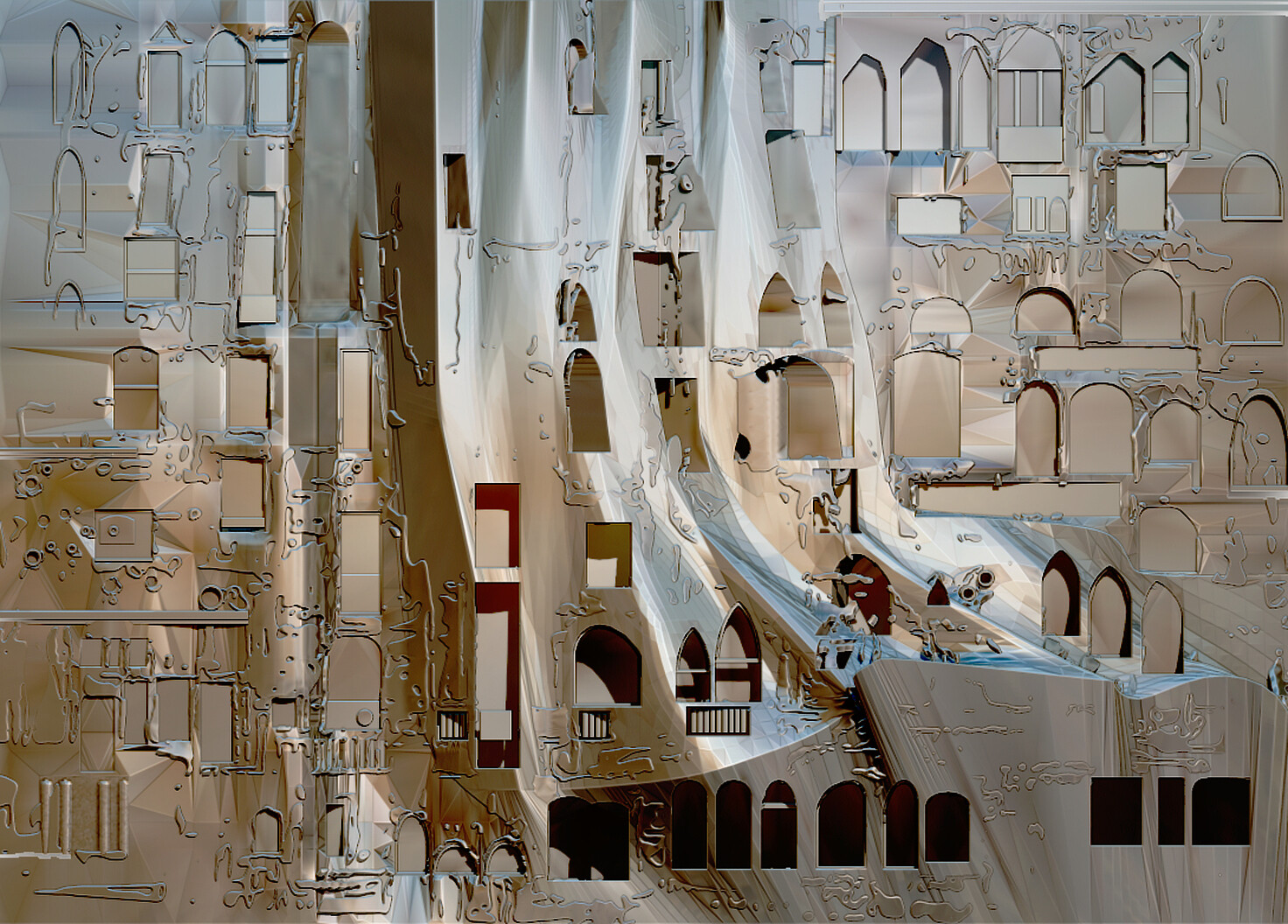The digitization of the contemporary world enables even the farthest reaches of our planet to be connected with relative ease and be transformed by devices, algorithms, and platforms that rely on information produced by the ever-growing digital economy.1 Yet when looking at the digitization of the built environment, a few contradictions appear. If architectural projects include those that are physically realized as buildings rather than as a practice of the academy, it is relatively obvious that the elements that make up a typical building are not assembled together in a factory in a vertically integrated production chain like an iPhone or Amazon Alexa. There are a few exceptions, but despite these advances, the physical production of our built environment remains heavily reliant on people out of the factory and in the field working on a one-off building site.
Architecture utilizes a model for labor which is highly analogue, leaning on an unskilled and transient labor force that is in short supply worldwide.2 The realization of buildings also typically uses a framework for project delivery known as “design-bid-build” that is highly fragmented and reliant on the precise coordination of a heavily striated workforce of contractors, sub-contractors, and even sub-sub-contractors. Logistically, this kind of framework creates an adversarial atmosphere, where responsibility, liability, and transparency become obstacles to a streamlined and efficient collaboration between stakeholders. The typical production chain even for small-scale projects such as a house are opaque, long, inefficient, and often extremely costly to the vast majority of clients who do not have the expertise or knowledge to understand, let alone comprehend the complexity of the processes required to realize a work of architecture.
The asymmetries that emerge from these conditions, when extrapolated to a global scale, drive inequity across the built environment, from who can afford access to specialist architectural knowledge to the precarity created in the gig economy of construction. Furthermore, the incredibly high amount of value placed on land—increasingly acknowledged as a symbol of the inequities created by neoliberalism—means that these asymmetries are further supported by a free and vastly unregulated market.3 This impacts the economic health of the built environment’s disciplines when there are any significant changes to the market, such as in 2008 when the construction industry in the UK fell into recession three times in a five year period.4
Architecture is complicit in these asymmetries. Despite overwhelming precarity in the capitalist market, the discipline has yet to seek to innovate its basic elements that perpetuate such logics. The building blocks that make up buildings—slabs, columns, beams, etc.—are designed, planned, manufactured, and assembled using processes that have not changed much since the industrial revolution. The very matter and the way we conceive the elements of what constitutes a building or a process of production for one has been relatively unaffected by the paradigm shift towards digitization. The fixity of functional building elements remains. A slab is a slab is a slab.
Some architects would argue that this is an absurd statement. Certainly, the proliferation of parametric software alongside programming, big data, machine learning, artificial intelligence, augmented and virtual reality, etc. have had an enormous impact on architectural conceptualization. There are very few practices that do not utilize modelling software, and many larger practices have invested in research groups focused on developing code or other specialized technologies.5 When one looks at the most common digital tools being developed now, one finds a focus on design tools such as Building Information Modelling (BIM), project management, or logistics to deal with the complexities of a contemporary project models.6 While this expansion of digital tools has influenced the smoothness and speed at which buildings are designed, it has still not influenced the way that buildings are constructed.
As has been often historicized, architectural software technologies were appropriated from computer sciences, ship-building, automobile, and aeronautical industries, as well as from biology, science fiction, and gaming.7 Therefore, in the words of Alan Colquhoun, the “tendency toward seeking the laws of architecture outside of architecture itself” is not a new practice within architectural culture.8 Indeed, it has been apparent throughout modernity. And as Sean Keller has recently described, this reaching outwards from the discipline has been oft used as a way to legitimize the “scale, expense, expertise, presence and permanence” of architectural forms.9
The splines, pixels, voxels, and bits associated with digital innovation and technological progress in the last several decades have enabled architectural form to be re-conceptualized not as static, permanent objects but as part of a larger network of data and communication between different kinds of architectural systems in a continuous state of flux.10 Yet as “digital architects” began to win large, mainly cultural, civic or other public commissions such as Guggenheim Bilbao (1991–1997) by Gehry Partners, Foreign Office Architect’s Yokohama Port Terminal (1995–2002), or the Mercedes Benz Museum (2001–2006) by UNStudio, it became clear that the potential to transform what architecture is comprised of when realized as buildings has largely settled into a kind of digital neo-formalism, privileging the symbolic, aesthetic, affective, and representational over developing a critical discourse around the bits and pieces of architecture.
Parametric software allows multiple inputs—from the environmental to the structural—to be congealed into complex, blobby, unfamiliar forms whose meaning is often ascribed to or appropriated from the sciences or cinema.11 However, due to the discontinuity between the way architects design with digital tools and the way that those designs are realized, digital architecture’s complex forms need to be “post-rationalized” in order to be realized using existing techniques, tools, and technologies of construction. Post-rationalization thus becomes about maintaining an efficiency of resources in relation to an exuberance of form. Low in this hierarchy is a consideration of what form is ultimately comprised of: parts. Such reduction of architectural realization to the ideologies of capital means that the whole, formal object of architecture becomes reliant on its justification as performative beyond the forces that shape and determine its realization.
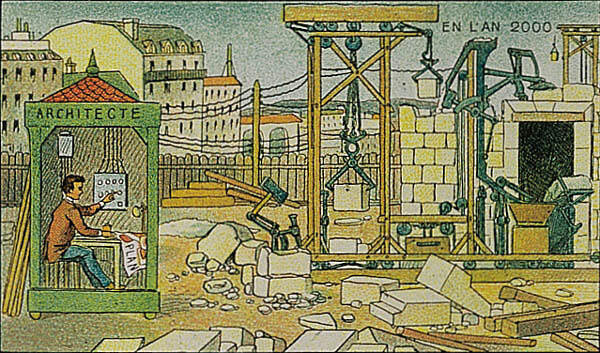

Villemard, Electric Construction Site, 1910. From the postcard series France in the year 2000, 1899–1910.
Towards A New “Digital Architecture”
Despite rapid digitization in almost all other industries, construction remains one of the least effected. This is made most obvious when one looks at construction’s production levels, or valued added per worker, which have remained stagnant since the mid-twentieth century. The McKinsey Global Institute has reported that “today, the industry is in a deadlock—to break it will require movement from all players.”12 Resources are now being dedicated towards advancing automation in construction at a large-scale. In the UK, there was £170 million announced to be invested by the government’s Industrial Strategy Challenge Fund.13 While this type of support is welcome, real innovation in construction automation requires a critical reading of contemporary architectural culture. For as Nick Srnicek explains in Platform Capitalism, “Phenomena that appear to be radical novelties may, in historical light, reveal themselves to be simple continuities.”14 As investment from venture capital and companies like WeWork, or projects like Airbnb Backyard and Alphabet’s Sidewalk Labs take control of our cities and modes of architectural realization, it is clear that without urgent engagement with the politics behind the current agents of change the disciplines of the built environment may suffer a great loss of architectural knowledge about design.15
Moves towards the automation of labor in architectural design and construction tend to be approached as a kind of revivalist Taylorism for the sake of economic efficiency, replacing human labor through the automation of bricklaying or construction vehicle mobility with single-task robots. It is not difficult to see the bricklaying-robot SAM, by Construction Robotics from 2016, for instance, as a continuity of Villemard’s vision of robotic production from 1910.16 Furthermore, increasing professionalization, legal responsibilities, and litigation has created a risk-averse climate of architectural production that subsumes innovation across the built environment within early modernist conceptions of architecture and their forms of construction: steel frame, pre-fab concrete, and post-and-beam timber. Parametric modelling’s emphasis on infinite variability therefore combines with the whole-to-part conceptualization required to realize the design and entails hugely inefficient and wasteful models for production, like expensive, custom building elements with long production chains.
Companies that have attempted to innovate with shorter production chains often fall into tropes which have existed for much of the twentieth century. For example, the platform-orientated construction startup Katerra utilizes a model of vertical integration not dissimilar to Tesla’s to produce standardized factory-made building products that hark back to the mass-prefabricated construction methods of Levittown or the infamous Soviet panel.17 On the other hand, projects like WikiHouse (2011-) utilizes decentralized modes of production similar to the fab lab model, yet is a highly bespoke, non-scalable, and customized model for architectural production. This is, of course, not to mention the fact that “parametric architecture” has libertarian politics as its most public representation such as Zaha Hadid Architects’ work in Qatar,18 or Patrik Schumacher’s position on social housing,19 which are antithetical to many architects who have, for example, engaged actively with principles derived from the open-source community.20
Instead of falling stray to the more homogenous, striated, segregated, and inequitable world that neoliberal perspectives on technology promote, architecture should be working towards forms and processes of digital and automated production that can facilitate and promote practices of equity, heterogeneity, and inclusivity. Simultaneously it is obvious that the dull, dangerous and dirty work of construction can now be greatly improved through the harnessing of computational power for large-scale, predictive, behavioral coordination to design safer, more agile, and prototypical forms of building.
An Urgency for the Discrete
The mass standardization of Maison Dom-Ino transformed the production of the post-war environment. Today, technologies of mass customization from the “first digital turn” make it so that architects no longer have to think of space as being constructed of fixed elements or objects.21 Technology exists today that can allow end-users to embed their own agency into the way that spaces are shaped, far beyond what was previously offered by commercial techniques of customization or personalization. Moving away from the whole-to-parts thinking common to the smooth curvilinear formalism of neoliberal parametricism (and universalist Modernism) requires the abstraction of architectural elements from fixed functions and their redirection towards geometry, tectonics, performance, and behavior. The digital architecture to come is one that thinks in discrete parts-to-whole relationships and is open-ended, scalable, generic, and versatile.
Embedded in cross-disciplinary discourse on digital materials, discreteness allows for a single set of building elements to be contextualized—that is, assembled—and re-contextualized—or disassembled and reassembled—in different scenarios.22 This understanding of architecture is the result of, and as Daniel Kohler has aptly observed, a response to “a crisis of objectivity.”23 Digital architecture ultimately requires a new ontology of built space, one that allows for a different understanding of the ecology between things. The relationship between individuals, society, and nature should not require or enforce predetermined hierarchies between parts, but instead emerge, as Gilles Retsin has argued, through “iterative accumulation,” seriality, and “recombination [in] different conditions.”24 The prototypical and generic nature of a discrete set of tectonic building elements enables the heterogeneity of contemporary life to impact and inform the realization of architectural space.
With a discrete approach, the dichotomy between the virtual—the way things are designed—and the physical—the way things are realized—becomes much smaller. Methods and processes of design, fabrication, and assembly become more streamlined. The role of the architect becomes less concerned with the final form a building may take, and instead engages more with the overarching economic, social, material, and technical framework in which it is produced. And while conceiving of architecture through the discreteness of its parts is not necessarily a new idea,25 combining it with ideas from open-source software and other participatory models of production has the potential to engage and give agency to a wider set of project stakeholders, including inhabitants, who can participate in its co-production over time.
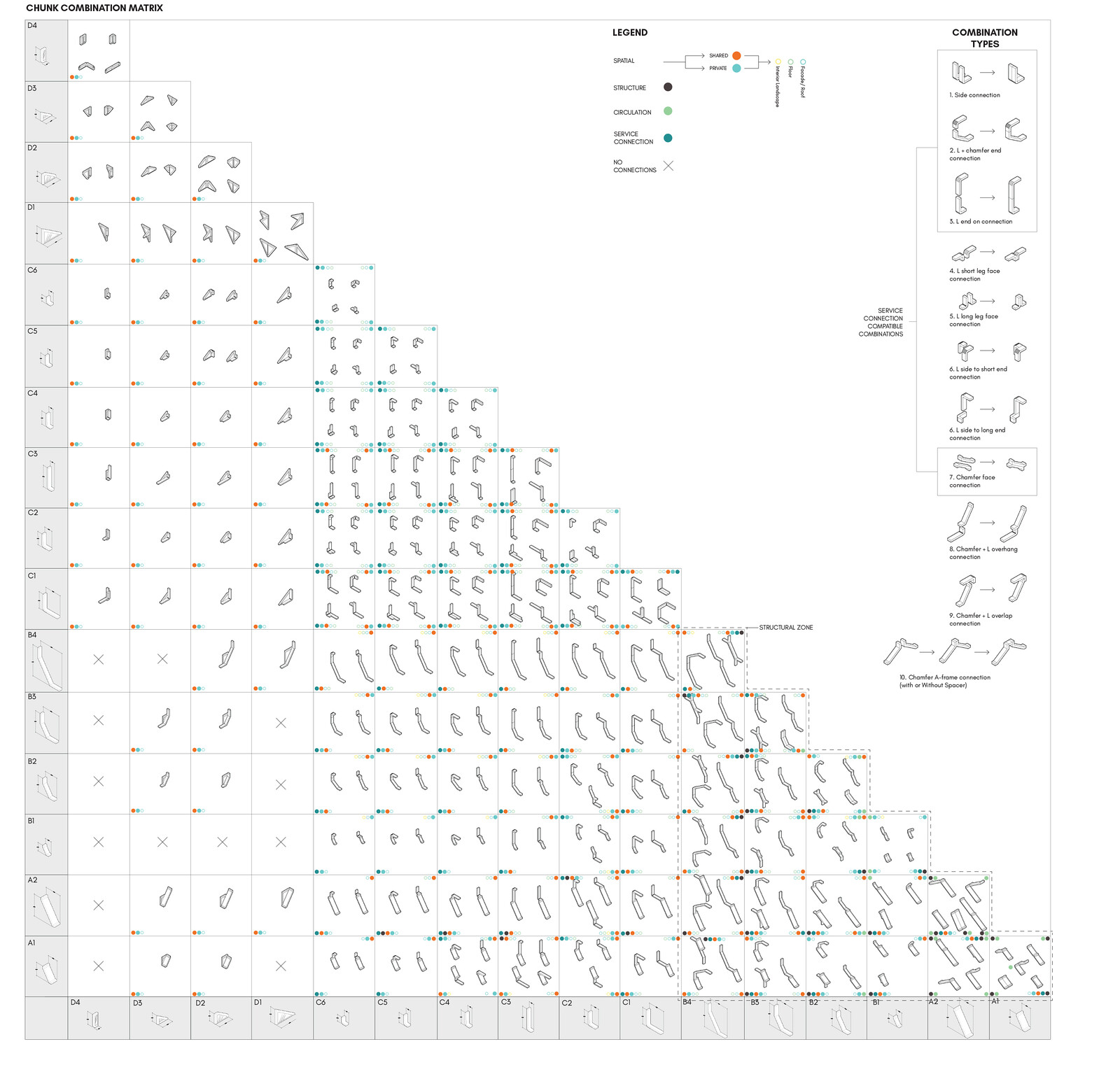
Matrix of connections of discrete parts. Image: Alessandro Conning-Rowland, Chamfer, Unit 19/DCL, 2018.
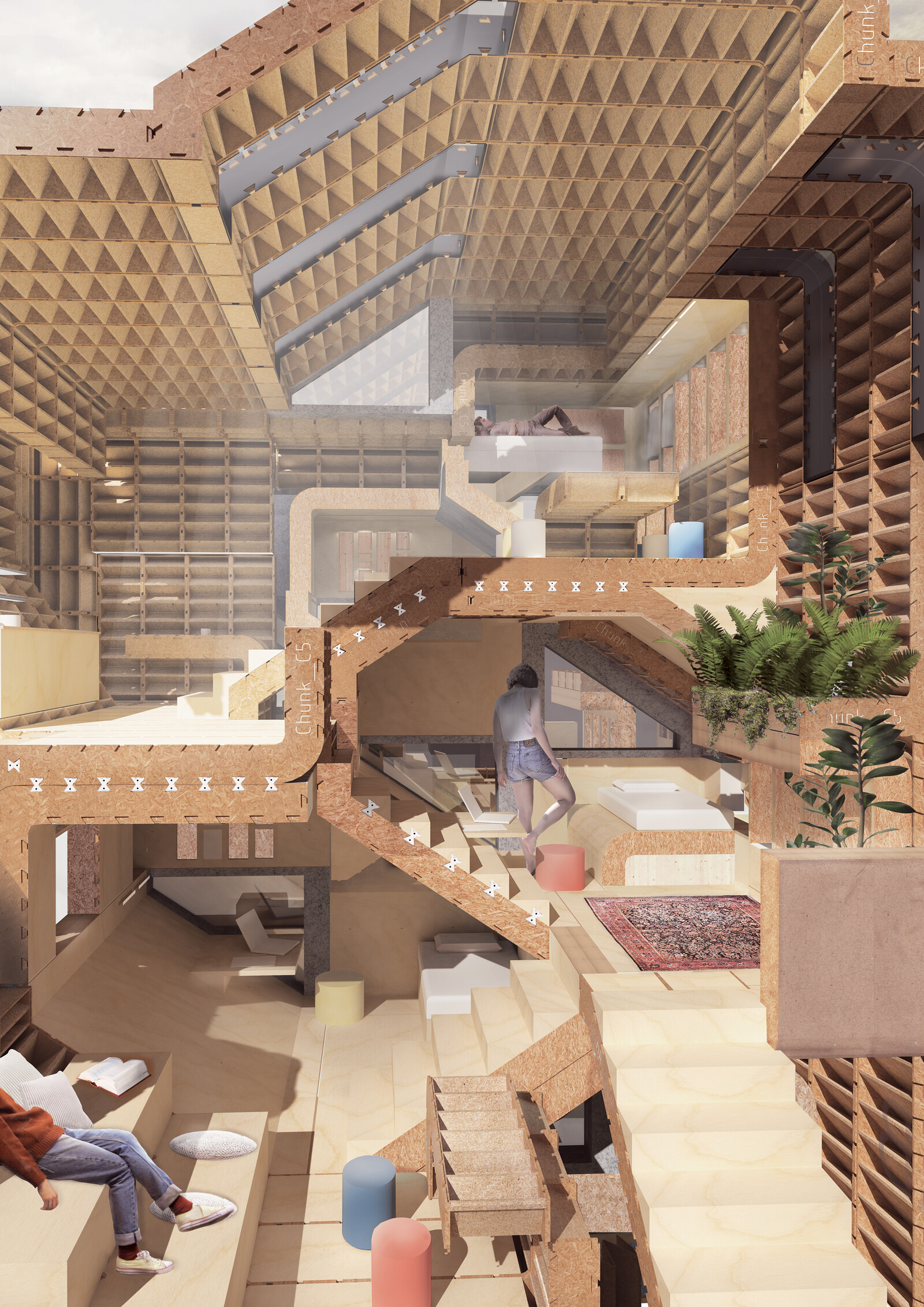
Interior view of shared space landscape of parts. Image: Alessandro Conning-Rowland, Chamfer, Unit 19/DCL, 2018.
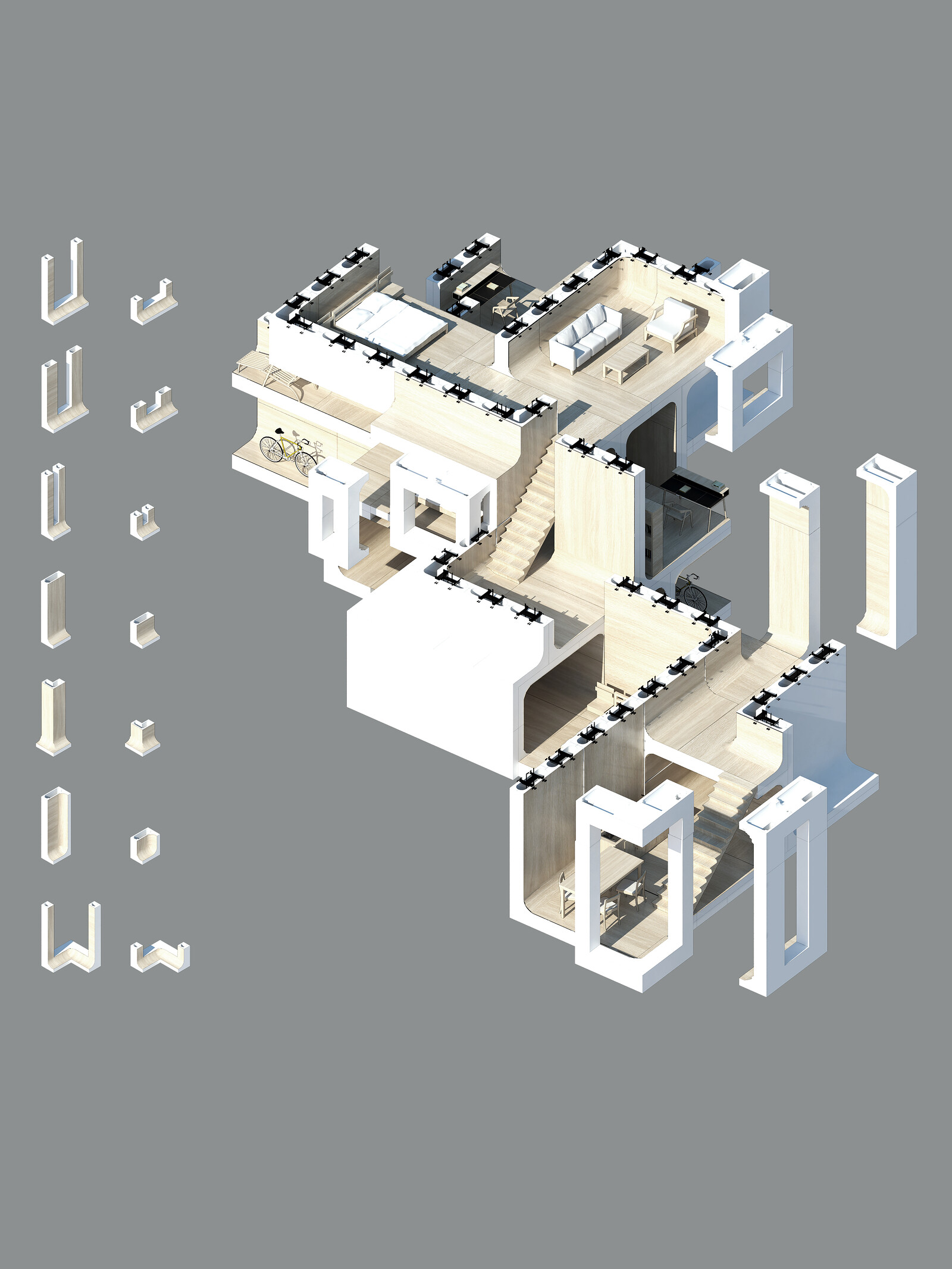
Parts and assembled and casted building chunk. Image: Ossama Elkholy, Cooperative Casting, Unit 19/DCL, 2018.
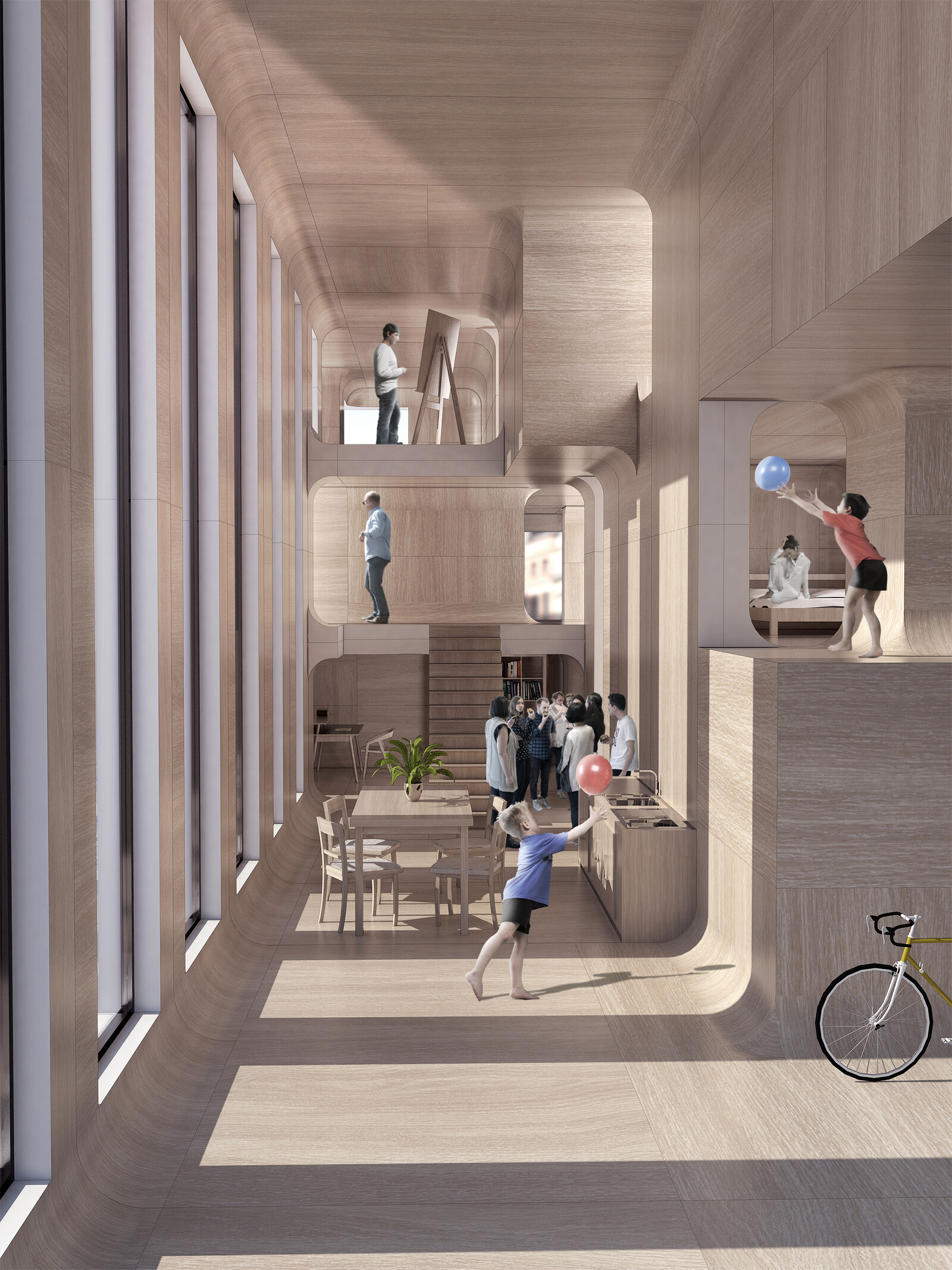
Internal view of finished section of cooperative housing. Image: Ossama Elkholy, Cooperative Casting, Unit 19/DCL, 2018.
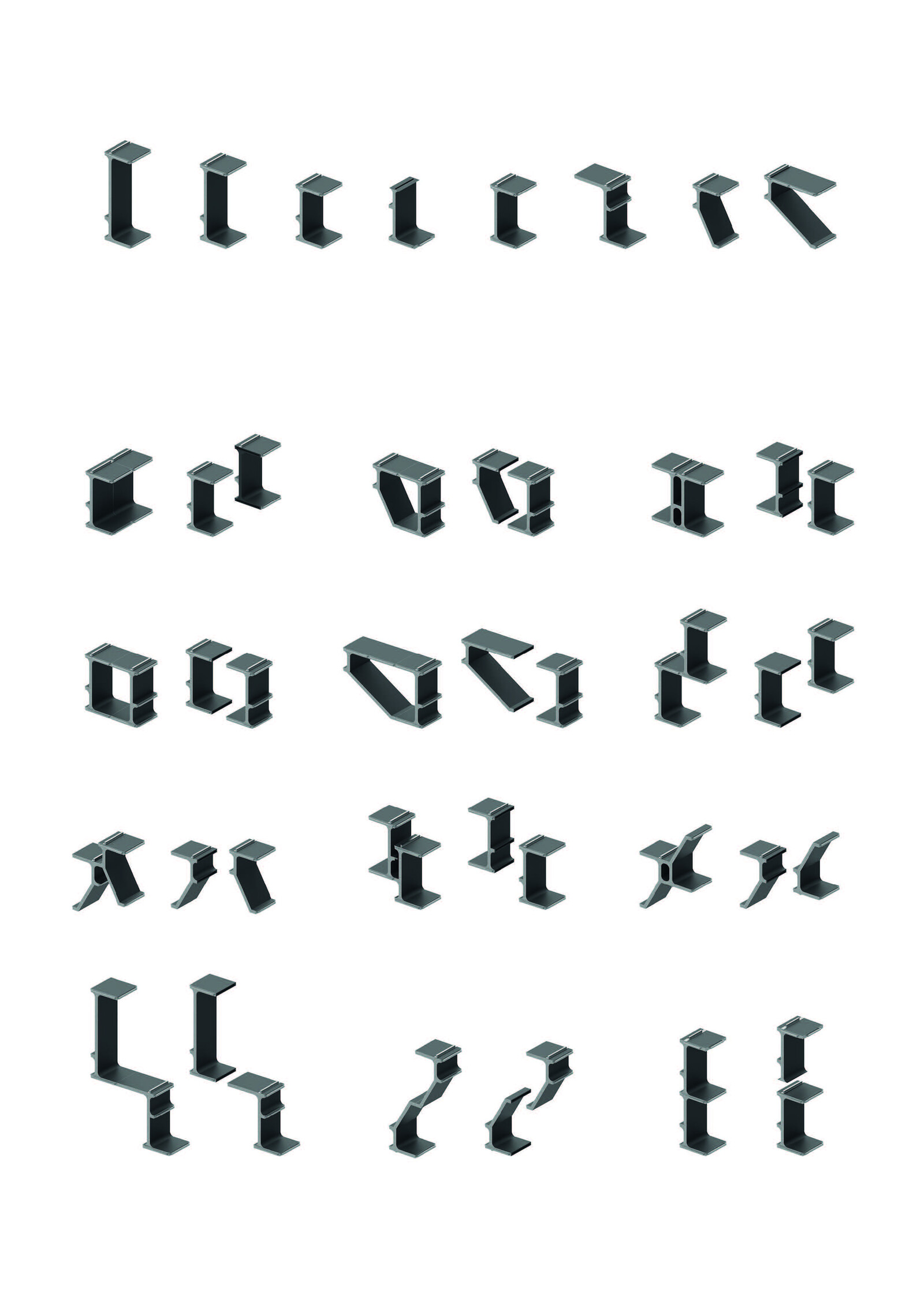
Matrix of building elements and combinations. Image: Julia Baltsavia, i-Architecture, Unit 19/DCL, 2017.
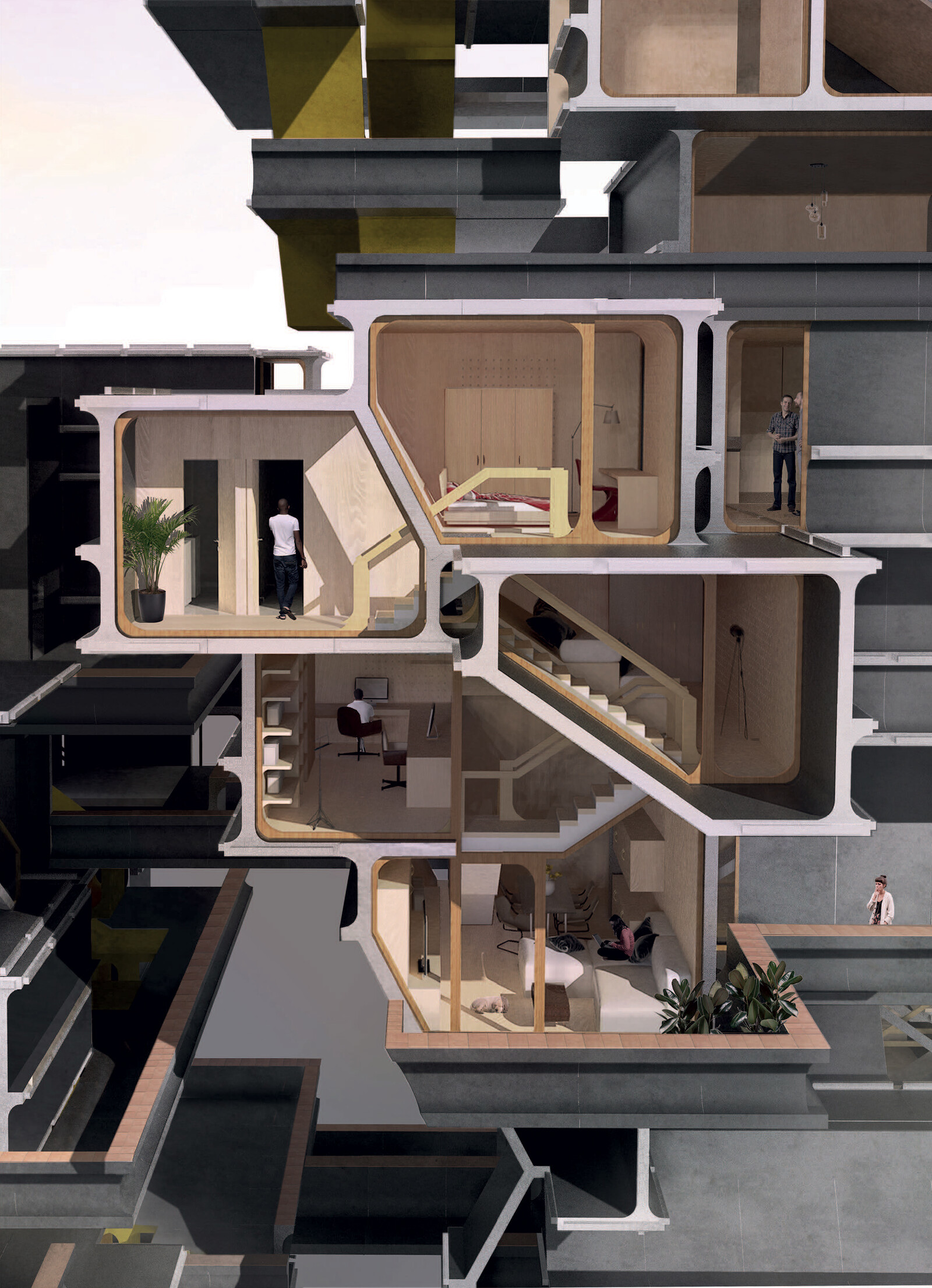
Prototypical tower assembly view inside apartments. Image: Julia Baltsavia, i-Architecture, Unit 19/DCL, 2017.
Matrix of connections of discrete parts. Image: Alessandro Conning-Rowland, Chamfer, Unit 19/DCL, 2018.
The Automation Gap
Automation provides a ground in which discreteness can address architectural innovation in construction, stagnancy in conceptualizing the digital, and more effective methods for public engagement in processes of its realization. Unlike fab labs, or venues that host “maker” communities commonly found around the world today, automation allows for a radical, large-scale, and horizontal rethinking of what the built environment is made of through an even-larger framework that takes as its starting point questions of accessibility, scalability, and logistics. The notion of “folk politics,” or a politics that “aims to bring politics down to the ‘human scale’ by emphasizing temporal, spatial and conceptual immediacy” as defined by Srnicek and Alex Williams, becomes useful here.26 Automation works in the opposite direction of folk politics: it works out, and up, rather than in and down. As Evgeny Morozov has written, folk political models like the fab lab suppress the development of large-scale infrastructure by localizing production without considering how to enable knowledge transfer across the network.27 They amplifies individual personal experience over systemic change.
Automation differs from these models in its ability to engage wide audiences and deal with complex logistics.28 The Design Computation Lab (DCL) at The Bartlett School of Architecture, UCL attempts to bridge the “automation gap” between how we live and how we produce the built environment. The research combines the generic and open-endedness of the discrete with the scale and accessibility of automation to speculate on how to catalyze labor’s obsolesce, or new forms and frameworks for labor that are aligned with other types of society. Students have speculatively developed multi-scalar production chains for automating the design and assembly of building, as well as space-making systems that are both socially engaged and economically disruptive to a given context.29 Others have developed novel fabrication and assembly methods using industrial and modular robotics as well as platforms for logistical coordination between architectural elements on a large-scale. The emphasis in these projects on the qualitative and emergent qualities of cultural production over the quantitative and fixed top-down brings the questions “why?” and “for whom?” that were intentionally unanswered by the architects of the first digital turn to the fore.
As Laboria Cuboniks writes, there is a need “strategically deploy existing technologies to re-engineer the world.”30 DCL’s research points towards the argument that this is not an impossible challenge, nor, in the words of Srnicek and Williams, is it “a free-floating project, since [the] frameworks … already exist and have traction in the world.”31 But technology must be contextualized in relationship to how it can and has been appropriated by and for the powerful, working against a system that would benefit the many for the sake of growth and capital. In its emancipatory potential, discrete architecture understands that those in state of disempowerment cannot “prevail over the strong with no strategic coordination.”32
Discrete architecture seeks to take the first step in using automation to confront the biases and privileges both inherited by and inherent to the disciplines of the built environment. There is great social, economic, and political consequence to how we design, fabricate, and assemble buildings, and some assumptions inherent to current discourse on socio-economic and technological progress might need to be overturned to rearticulate the power relations sustained by our cities. An awareness of the various forces and actors at play in the automation of the built environment needs to be engaged with more rigorously, and with less innocence.
Michael G. Jacobides, Arun Sundararajan, and Marshall Van Alsytne, “Platforms and Ecosystems: Enabling the Digital Economy,” World Economic Forum, February 2019, ➝.
Construction Leadership Council, Shortage occupations in construction (January, 2019), ➝.
Robin Grey, Tom Kenny, Laurie Macfarlane, Anna Powell-Smith, Guy Shrubsole, and Beth Stratford, Land for the Many, George Monbiot, ed., (June 2019), ➝.
Department for Business Innovation & Skills, UK Construction: An economic analysis of the sector (July 2013), ➝.
Such as ZHA Code at Zaha Hadid Architects, Foster & Partners’ Specialist Modelling Group, or Gehry Technologies.
Procore, a project management software company, is one of the few investment unicorns in construction.
Mario Carpo, The Second Digital Turn: Architecture in the Age of Intelligence (Cambridge: MIT Press, 2017).
Alan Colquhoun, “Frames to Frameworks,” Encounter 48 (April 1977): 41.
Sean Keller, Automatic Architecture (Chicago: The University of Chicago Press, 2017), 1.
Mario Carpo, “Breaking the Curve: Big Data and Design”, Artforum, February 2014, ➝.
Greg Lynn, Animate Form (Princeton: Princeton Architectural Press, 1999).
McKinsey Global Institute, “Reinventing construction: a route to higher productivity,” McKinsey & Company, February 2017; McKinsey Global Institute, “The construction productivity imperative”, McKinsey & Company, July 2015.
UK Research and Innovation, “Transforming construction,” ➝.
Nick Srnicek, Platform Capitalism (London: Polity Press, 2016), 9.
Construction Robotics, “SAM100,” ➝.
Katerra, “Katerra TAKE OFF 2019 | Building Platforms,” YouTube.
Salvatore Peluso, “Zaha Hadid Architects’ Al Janoub Stadium represents the inequalities of our time,” DomusWeb, May 29, 2019, ➝.
Amy Frearson, “Patrik Schumacher calls for social housing and public space to be scrapped,” Dezeen, November 18, 2016, ➝.
Such as Jose Sanchez, Maria Yablonina, Gilles Retsin, Manuel Jimenez Garcia, Viola Ago, Carlo Ratti, Marcin Jakubowski, and others.
Mario Carpo, The First Digital Turn: 1992-2012 (John Wiley & Sons, 2012).
Neil Gershenfeld, Matthew Carney, Benjamin Jenett, Sam Calisch, and Spencer Wilson, “Macrofabrication with Digital Materials: Robotic Assembly,” Architectural Design 85, no. 5 (2015): 123. Current discourse on the discrete includes the work of Daniel Kohler and his ‘mereological’ quantification of urbanism to Jose Sanchez’s project to connect the discrete to participatory systems and the establishment of a new architectural commons to Gilles Retsin’s research on discrete and digital serially-repetitive tectonic systems. Philippe Morel’s work with the Computational Chair (2004) explored the potential of voxel-based systems in relationship to automated manufacturing. My fellow co-directors in Design Computation Lab at The Bartlett School of Architecture UCL, Gilles Retsin, Manuel Jimenez Garcia, and Vicente Soler are also voices exploring the potential of these ideas. See Daniel Köhler, “Large City Architecture: the mereological mode of the quantified city,” International Journal of Parallel, Emergent and Distributed Systems (2017): 32; Jose Sanchez, “Combinatorial Commons: Social Remixing in a Sharing Economy”, Architectural Design 87, no. 4 (2017): 19; Gilles Retsin “Bits and Pieces,” Architectural Design 89, no. 2 (2019): 38–45.
Daniel Kohler, The Mereological City: a reading of the works of Ludwig Hilberseimer (transcript Verlag, 2016), 9.
Retsin, “Bits and Pieces,” 41.
Having origins in the work of Walter Segal, Christopher Alexander, Richard Deitrich, and Jean Prouvé as well as other twentieth century architects.
Nick Srnicek and Alex Williams, Inventing the Future: Postcapitalism and a World Without Work (London: Verso, 2015), 9–13.
Evgeny Morozov, “Making It,” The New Yorker, January 13, 2014, ➝.
As MIT researcher Nadya Peek has pointed out, the fab lab does not enable wide participation. See Nadya Peek, Machines that Make (Ph.D. Thesis, Massachusetts Institute of Technology, School of Architecture and Planning, Program in Media Arts and Sciences, 2016).
In its last iteration in academic year 2017–2018, Unit 19 was contextualized in London, which is the context in which RC4 is now working in the academic year 2018-19.
Laboria Cuboniks, Xenofeminsm: A Politics for Alienation (2015), ➝.
Nick Srnicek and Alex Williams, Inventing the Future: Postcapitalism and a World Without Work (London: Verso, 2015), 107.
Laboria Cuboniks, “Trap,” Xenofeminsm, ➝.
Becoming Digital is a collaboration between e-flux Architecture and Ellie Abrons, McLain Clutter, and Adam Fure of the Taubman College of Architecture and Urban Planning.
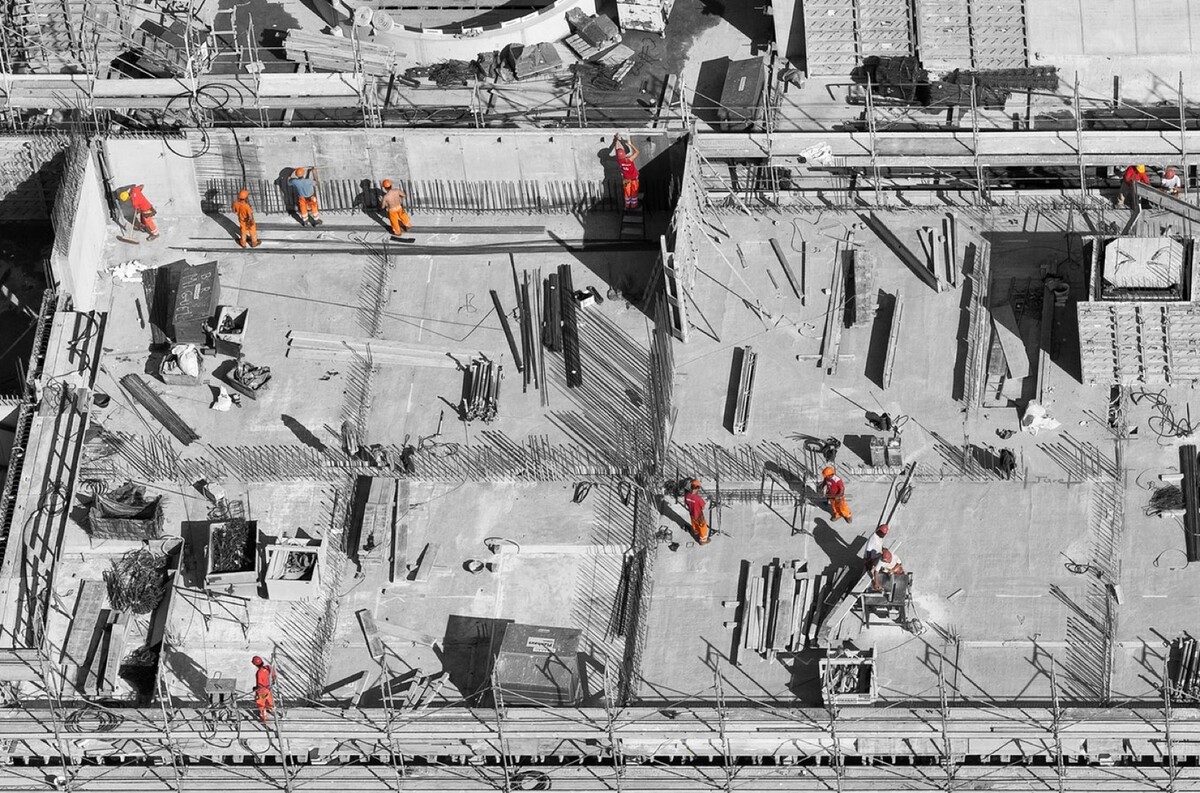
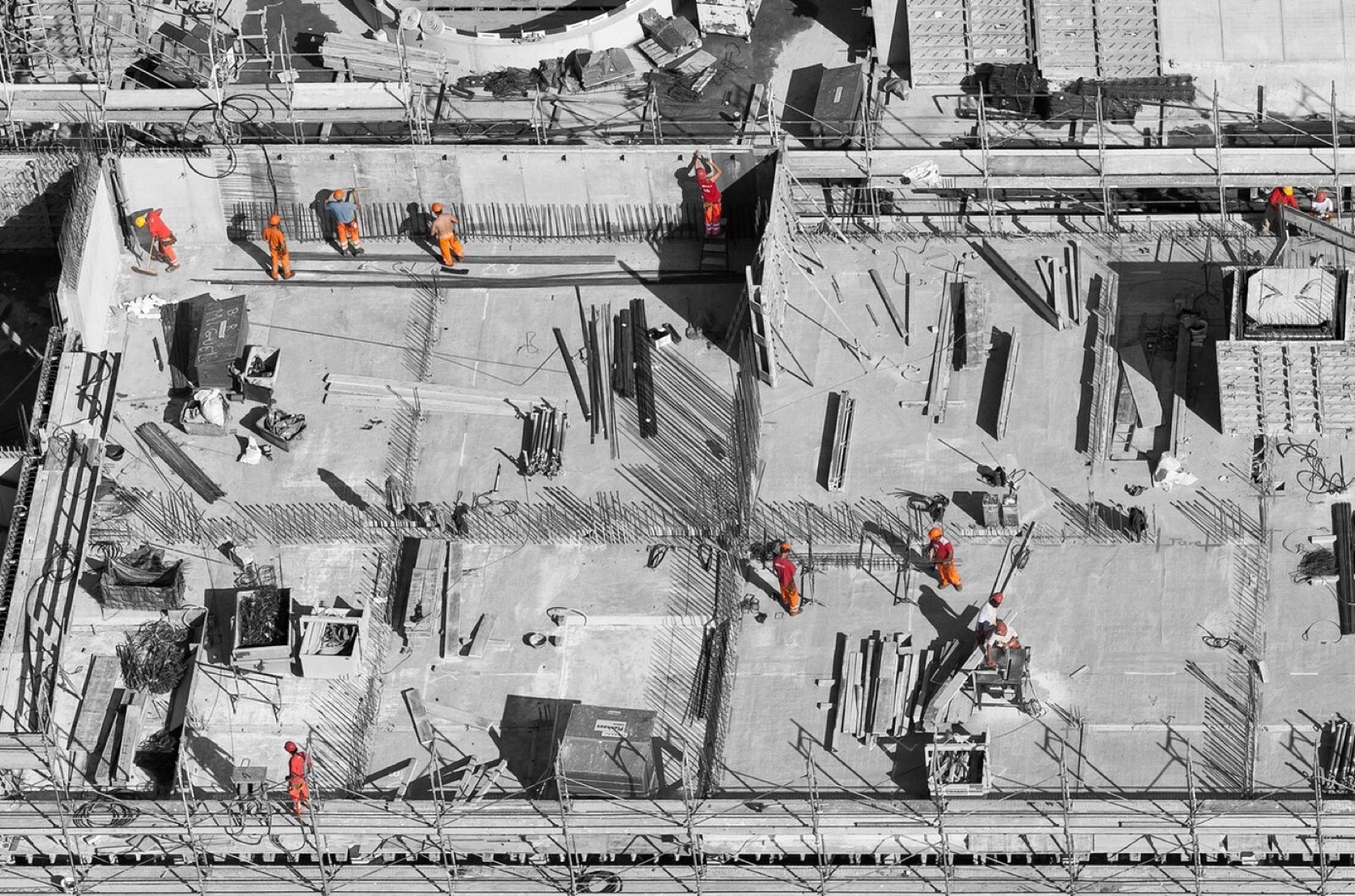




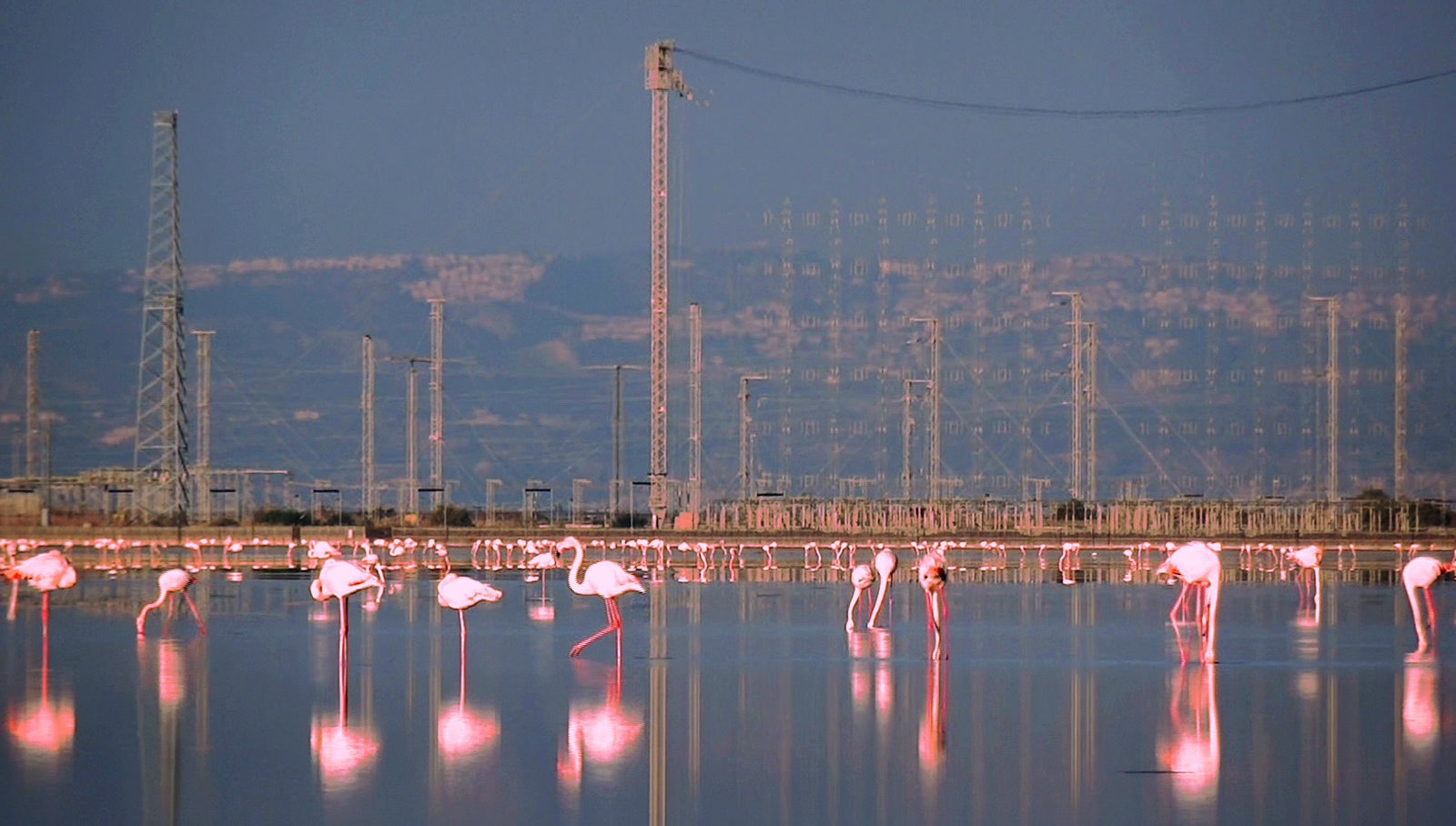
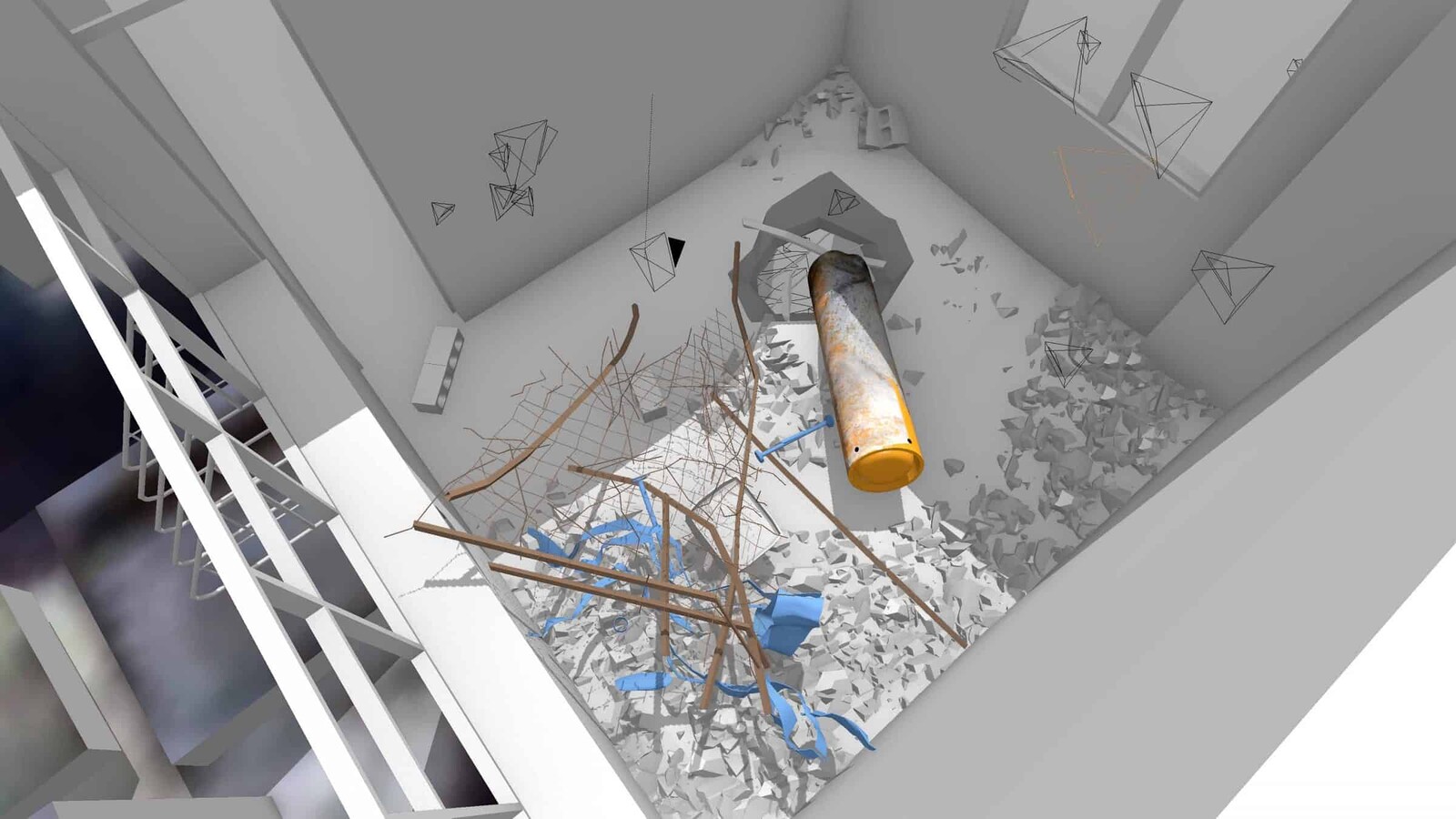


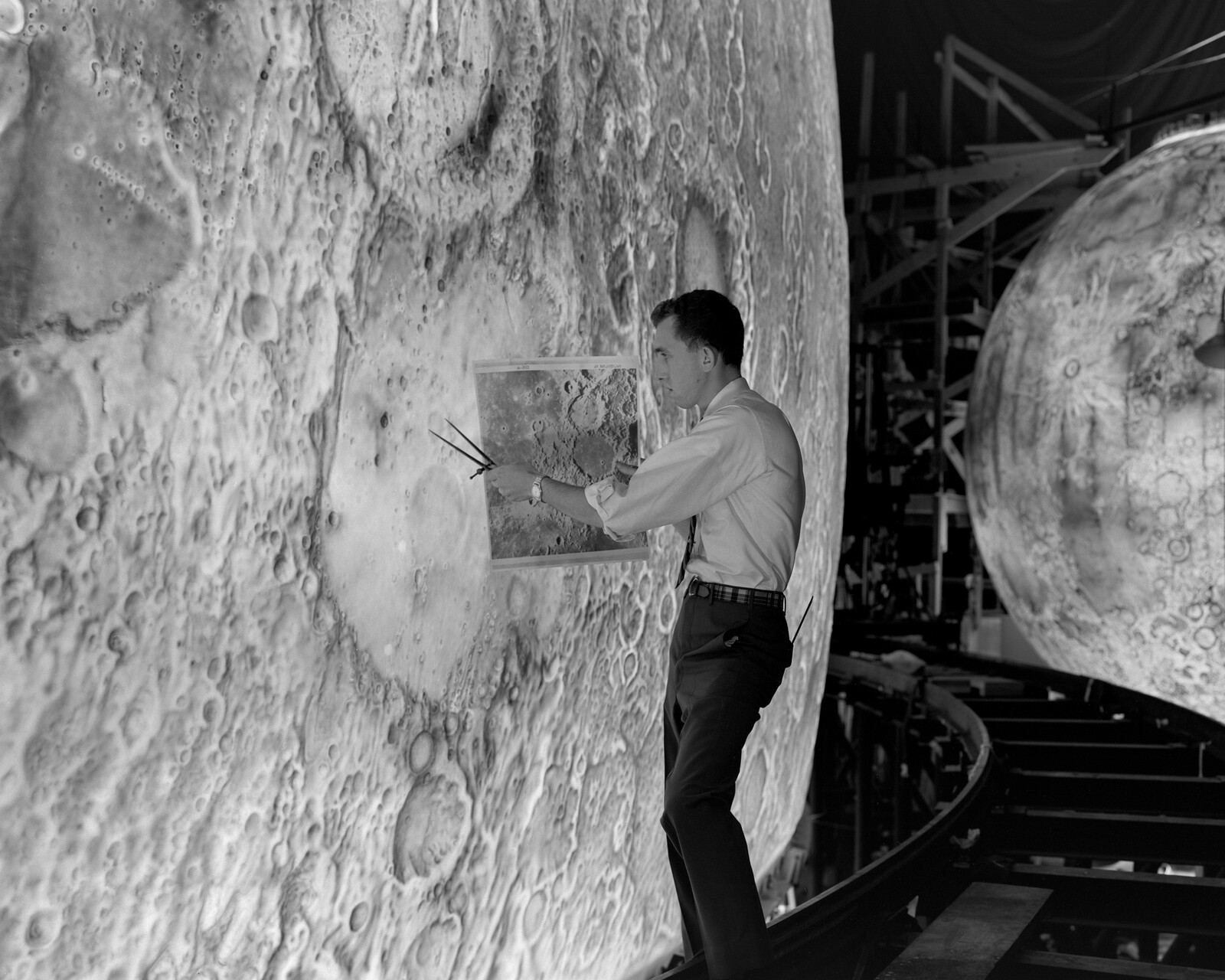
.jpg,1600)


